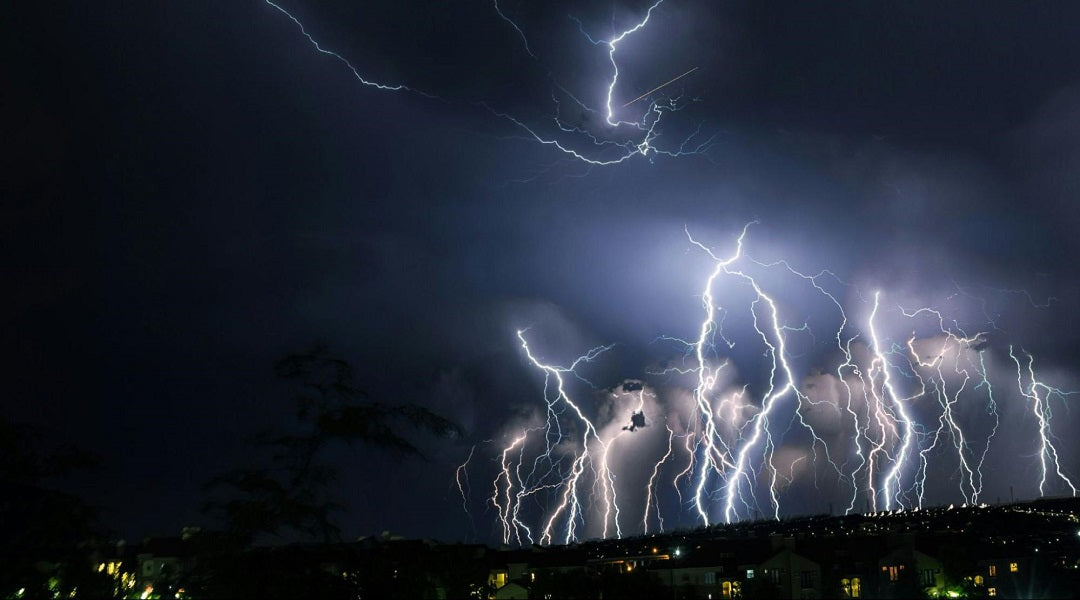Solar panel lightning protection is an essential part of a photovoltaic setup—it prevents lightning damage to solar panels, maintains their functionality, and keeps your home safe.
Lightning strikes and solar systems don’t go well together—a direct hit can cause severe electrical damage, fires, or complete system failure. In fact, even nearby strikes can lead to power surges that can compromise system performance.
In this article, we’ll explore solar panel lightning protection equipment in detail, offering maintenance and installation tips. Additionally, we’ll look into the best solar panel storm safety practices to help you safeguard your system against extreme weather conditions. Let’s begin!
Why It’s Important to Protect Solar Panels from Lightning
Solar panel lightning protection minimizes the risk of system damage and fire hazards. When lightning strikes, whether directly or nearby, it can send a sudden, powerful surge of electricity through the system’s wiring. This high voltage can melt or burn the wiring, fuses, and the solar inverter connected to the panels.
In addition, the intense heat from a lightning hit can start a fire, most likely in the inverter or other electrical components.
The damage can also be physical—while solar panels can generally withstand different weather conditions, a lightning strike can crack their surface and destroy photovoltaic cells.
In the worst-case scenario, a powerful lightning strike can completely disable the system, leading to expensive repairs or even the need for a full replacement.
Even if the system survives a lightning strike, it can still suffer from long-term damage. Components like solar batteries, inverters, and wiring can degrade over time, reducing the system’s overall efficiency.
That said, the need for portable solar panel protection is even greater, as these panels are typically more exposed to the elements since people mostly use them in outdoor settings. Unlike permanent setups, they generally don’t have proper grounding or surge protection systems, which means they’re more vulnerable to lightning strikes.
Even improper storage of portable panels during storms can leave them at risk of damage from electrical surges.
How to Protect Solar Panels from Lightning

To protect your solar panels and other components of the system from lightning, you need the right equipment. Just to be on the safe side, you should also remember to turn the system off before a storm. This way, you’ll ensure that your solar setup continues to power your home with solar energy at peak performance.
Let’s explain the solar panel lightning protection measures more closely:
#1. Surge Protectors
Solar array surge protection ensures the electrical components of your system are shielded from damaging power spikes. This means that surge protection devices (SPDs), or surge protectors, protect solar inverters from lightning, stopping any sudden bursts of energy from going through the system’s wiring.
These devices typically come in three types:
- Type 1: Positioned at the meter location or breaker panel, it works with other lightning protection devices to disperse the strong currents generated by direct lightning hits.
- Type 2: Installed on or near the distribution board, it protects the system from indirect lightning strikes, either with lightning rods or independently.
- Type 3: Designed to protect individual devices that are over ten meters away from one of the two previous types.
#2. Grounding
Grounding solar panels is a crucial safety measure against electrical faults caused by lightning strikes. It involves connecting the metal parts of the panels and other components of the system to the earth through a grounding wire. As a result, any excess electrical charge is safely redirected into the ground.
By dissipating lightning overvoltage, a good grounding system reduces the risk of equipment damage, electrical shocks, and fires. Aside from improving the system’s stability, it also ensures compliance with electrical safety codes.
#3. Lightning Rods and Arrestors
Lightning rods for solar systems are metal bars installed high above solar arrays to attract lightning strikes. They’re directly connected to the grounding system, helping channel the lightning’s electrical energy into the ground so it doesn’t hit the panels and other components.
On the other hand, lightning arrestors for solar panels are devices that protect against sudden power surges from nearby lightning hits. Unlike rods, they don’t attract lightning—instead, they block or divert excess voltage away from the panels.
#4. Disconnecting Devices
One of the most important solar panel lightning protection measures is shutting the system down during a storm to reduce the flow of electricity. Namely, when your system is active, it generates and conducts electricity around the clock, making its components more vulnerable to sudden power spikes.
Consequently, turning the system off decreases the chances of an electrical surge traveling through it and causing damage. Additionally, by deactivating the system, you can isolate sensitive equipment, protecting it from indirect lightning strikes that could enter through the grid or external wiring.
If you have an off-grid system with a solar generator, you should also turn it off when a storm is approaching.
Solar Panel Lightning Protection: 5 Maintenance and Installation Tips

Now that you know what kind of equipment you need, let’s take a look at solar panel lightning protection maintenance and installation tips:
#1. Professional Installation vs. DIY Options
DIY solar setups can save money, but solar panel lightning protection is too important to risk mistakes. Professionals have the expertise to install grounding systems, surge protectors, and wiring correctly, minimizing the chance of damage.
That said, if you’re experienced in electrical work and solar installations, you might handle a simple setup. Still, it’s best to leave complex systems to professionals to ensure safety standards.
#2. Ensure Proper Grounding
To ground your solar system properly, you need to connect all its metal parts, including the solar panel frames, mounting racks, and inverter, to a grounding rod driven deep into the earth. Use thick, corrosion-resistant copper or aluminum wires for this, as they’re the best for creating solid connections.
Moreover, make sure that all grounding points are secure—there should be no loose or frayed wires.
#3. Regularly Maintain Your Panels
Regular maintenance of solar panels reduces the risk of lightning-related damage. For this reason, take some time every once in a while to inspect your setup for loose wires, corrosion, or signs of wear, especially after a storm.
If you notice that some parts are damaged, make sure to repair or replace them as soon as possible, as they can make your system more vulnerable to power surges.
#4. Choose the Right Location
Where you install your solar panels can make a difference in how vulnerable they are to lightning. For example, you shouldn’t place them near tall, isolated structures like single trees because they can attract lightning.
Instead, try to mount them as close to the ground as possible or near other grounded structures. This way, your system will be less likely to suffer a direct lightning strike.
#5. Install Surge Protection Devices
Installing solar panel surge protection devices requires identifying key points in your system where the surges can enter. These are the inverter, the main electrical panel, and the area near the solar array. Mount the SPDs close to them to minimize wiring length—this way, they’ll respond to surges faster.
At this point, you need to connect the SPDs to both the live and ground wires. Make sure the connections are tight and secure, or better yet, have an electrician check them for maximum safety.
Best Practices for Protecting Your Solar Panels During Storms

Storms can be unpredictable, and even with the best protection, your panels are still vulnerable to lightning, strong winds, and heavy precipitation. Therefore, taking extra precautions before, during, and after a storm can help prevent severe damage.
Here are some simple practices to keep your solar power system safe during storms:
#1. Monitoring Weather Forecasts
Staying ahead of the weather is the first line of defense, so you should keep an eye on local forecasts, especially during storm seasons. You can also set up weather alerts on your phone to notify you when a storm is approaching. That way, if severe weather is predicted, you’ll have time to prepare, whether that means shutting down your system, securing loose components, or moving portable panels somewhere safe.
#2. Disconnecting Solar Panels
If there’s a storm on the way, it’s advisable to disconnect your panels temporarily to prevent electrical surges from going through the system. For portable setups, all you need to do is unplug the panels and store them in a dry, sheltered place.
On the other hand, if you have a fixed system, you should switch off the inverter and disconnect the panels from the main power source (if it’s safe to do so).
#3. Checking for Damage After the Storm
Once the storm has passed, inspect your solar system for damage. Look for cracked panels, burnt wiring, or signs of water getting into electrical components. Pay close attention to the inverter and surge protectors, as they generally absorb the majority of power surges.
Choose the Safest Solar System Installation Option
Having solar panel lightning protection equipment properly installed is crucial for keeping your system safe and efficient. This applies to the entire solar setup, which is why you need to choose your provider wisely.
With Portable Sun’s installer program, you can rest assured your system is set up with utmost care, letting you harness the power of sunlight without worrying about lightning damage.
Final Thoughts
Going solar allows you to have an eco-friendly lifestyle and save money in the long run if you take good care of your photovoltaic system. In addition to proper maintenance and cleaning, this includes taking solar panel lightning protection measures to shield your setup from harsh weather conditions.
By investing in the right protection, you’re ensuring your system stays safe, efficient, and ready to provide clean energy for years to come. Taking precautions like grounding, surge protection, and disconnecting during storms will safeguard your investment and get you the most out of solar energy, even in bad weather.
Solar Panel Lightning Protection FAQ
#1. Are solar panels resistant to lightning?
Solar panels aren’t resistant to lightning. Even though they can withstand some weather conditions, a direct strike can crack their surface or damage the electrical components connected to them.
#2. Where to install surge protectors in a solar power system?
Surge protectors should be installed near key points of a solar power system. These include the inverter, the electrical panel, and the area near the solar array.
#3. What happens if lightning hits a solar panel?
If lightning hits a solar panel, it can cause both physical and electrical damage. For instance, it can crack the panels’ surface, melt or fry electrical parts, or even start a fire.
Disclaimer: The content on Portable Sun is for informational purposes only. Electrical work can be dangerous—always consult a qualified professional. We are not liable for any injuries, damages, or losses from installation or use. Always follow local regulations and safety guidelines when handling electrical components.

